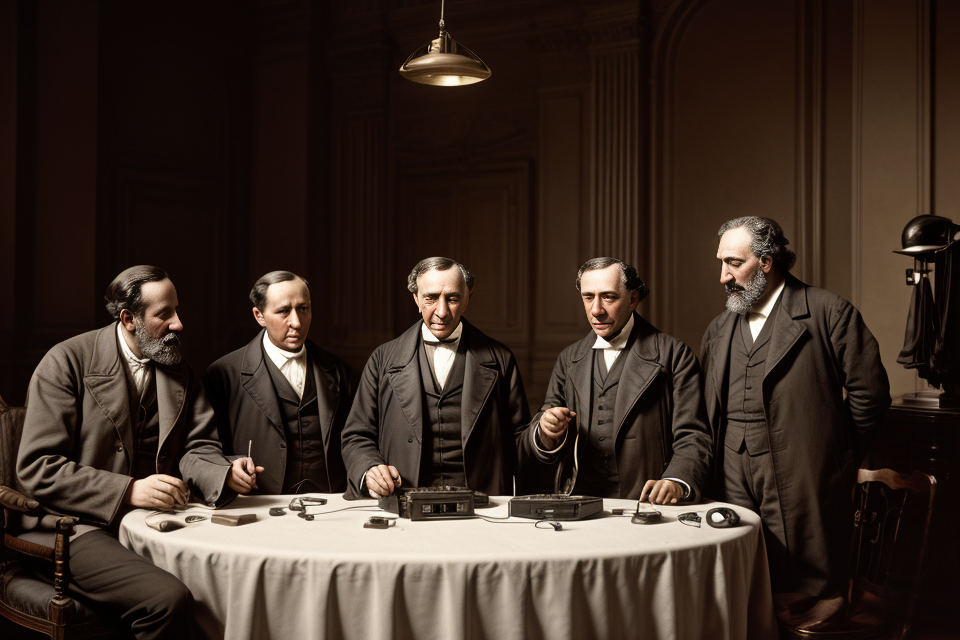
Wireless communication has revolutionized the way we communicate, connect and transmit information. It has enabled us to communicate over long distances without the need for physical cables or wires. But have you ever wondered why wireless communication was invented in the first place? The answer lies in the need for faster and more efficient communication. Wireless communication was invented to overcome the limitations of traditional wired communication systems, which were slow, cumbersome and expensive. The invention of wireless communication has enabled us to communicate in real-time, across continents and oceans, and has transformed the way we live, work and play. Join us as we explore the fascinating history and evolution of wireless communication and discover why it was invented.
Wireless communication was invented to enable the transmission of information and communication over distances without the use of physical wires or cables. This was achieved through the use of electromagnetic waves, which can travel through the air and are capable of carrying voice, data, and other forms of information. The invention of wireless communication revolutionized the way people communicate and access information, enabling the development of new technologies such as mobile phones, Wi-Fi, and satellite communication. The ability to transmit information wirelessly has greatly facilitated the exchange of ideas and has had a profound impact on many aspects of modern life, including business, entertainment, and education.
The Need for Wireless Communication
The History of Wireless Communication
The history of wireless communication dates back to the late 19th century, when the first wireless experiments were conducted. These early experiments involved the transmission of radio waves over short distances, and they laid the foundation for the development of wireless communication as we know it today.
One of the earliest pioneers of wireless communication was Guglielmo Marconi, an Italian physicist who developed the first practical wireless communication system in the 1890s. Marconi’s system used a device called a coherer, which consisted of a wire with a metal filing inside that would stick together when exposed to radio waves. This allowed Marconi to transmit Morse code messages over distances of several kilometers.
In the early 20th century, wireless communication continued to evolve, with the development of new technologies such as the vacuum tube and the transistor. These advances made it possible to transmit radio signals over longer distances and to develop more sophisticated communication systems.
During World War II, wireless communication played a crucial role in military operations, with radar systems used to detect enemy aircraft and radio communication used to coordinate troop movements. After the war, the development of satellite technology made it possible to transmit wireless signals over even greater distances, paving the way for the global communication networks we have today.
Overall, the history of wireless communication is one of continuous innovation and technological advancement, driven by the need to overcome the limitations of traditional wired communication systems and to enable faster, more efficient communication over long distances.
The Benefits of Wireless Communication
Wireless communication has revolutionized the way we communicate and has become an essential part of our daily lives. The benefits of wireless communication are numerous and can be summarized as follows:
- Convenience: Wireless communication has made it possible to communicate on the go, without the need for physical connections or cables. This has made it easier to stay connected with friends and family, no matter where you are.
- Efficiency: Wireless communication has increased efficiency in both personal and professional settings. With the ability to communicate instantly and easily, people can work more effectively and collaborate more efficiently.
- Cost Savings: Wireless communication has also helped to reduce costs associated with traditional communication methods, such as phone lines and cables. This has made it more accessible to people who may not have been able to afford these traditional methods.
- Flexibility: Wireless communication has provided people with greater flexibility in terms of how and when they communicate. This has allowed for more spontaneous and impromptu communication, which can be beneficial in a variety of situations.
- Accessibility: Wireless communication has made it possible for people to access information and communicate with others in areas where traditional communication methods may not be available. This has been particularly beneficial in remote or underserved areas, where access to information and communication can be limited.
Overall, the benefits of wireless communication are numerous and have had a significant impact on the way we live and work. It has enabled us to stay connected with others, work more efficiently, and access information and communication in new and innovative ways.
The Invention of Wireless Communication
The First Wireless Communication Systems
The history of wireless communication dates back to the late 19th century when scientists and inventors began experimenting with transmitting and receiving information without the use of wires. The first wireless communication systems were developed to address the limitations of traditional wired communication systems, which were expensive, cumbersome, and difficult to maintain.
One of the earliest wireless communication systems was developed by Italian inventor Guglielmo Marconi, who is credited with the invention of radio communication. Marconi’s system used radio waves to transmit Morse code signals over short distances, and he demonstrated the system’s effectiveness by transmitting a message from a ship to a shore station in 1899.
Another early wireless communication system was developed by Nikola Tesla, who is best known for his work on alternating current (AC) electricity. Tesla’s system used radio waves to transmit electrical energy wirelessly over long distances, and he demonstrated the system’s feasibility by transmitting electrical power from a power plant in New York City to a receiver in a nearby building in 1887.
These early wireless communication systems were crude by modern standards, but they marked the beginning of a new era in communication technology. They paved the way for the development of more advanced wireless communication systems, such as the wireless telephone and the modern cellular network, which have revolutionized the way people communicate and access information.
The Evolution of Wireless Communication Technology
Wireless communication has come a long way since its inception. It was not developed overnight but was the result of years of research and experimentation. The evolution of wireless communication technology can be traced back to the late 19th century when several inventors began working on wireless telegraphy.
One of the earliest inventors of wireless communication was Guglielmo Marconi, an Italian physicist who is credited with the development of the first practical wireless telegraph system. Marconi’s system used a coherer, a device that could detect electromagnetic waves, to transmit Morse code signals over a distance of several kilometers.
Marconi’s invention paved the way for further developments in wireless communication. In the early 1900s, several inventors, including Nikola Tesla and Reginald Fessenden, began experimenting with wireless voice transmission. Tesla was the first to transmit a wireless voice signal over a distance of several kilometers, while Fessenden is credited with the first successful broadcast of a voice message to a large audience.
During the early 20th century, several other inventors made significant contributions to the development of wireless communication. In 1920, the first commercial radio broadcast was made by the American broadcasting company, NBC. The 1930s saw the development of radar technology, which used radio waves to detect the presence of aircraft and ships.
In the years following World War II, several technological advancements were made in the field of wireless communication. In 1947, the transistor was invented, which enabled the development of smaller and more efficient electronic devices. The 1960s saw the development of satellite communication, which allowed for long-distance communication without the need for physical cables or wires.
Today, wireless communication is an integral part of modern life. It is used in a wide range of applications, from mobile phones and Wi-Fi to satellite communication and GPS systems. The continued evolution of wireless communication technology is likely to bring about even more innovations in the future.
Applications of Wireless Communication
Mobile Communication
Mobile communication is one of the most significant applications of wireless communication. It enables people to communicate on the go, without being tied to a fixed location. This has revolutionized the way people live and work, providing them with the ability to stay connected wherever they are.
Here are some of the key benefits of mobile communication:
- Convenience: With mobile communication, people can stay connected even when they are on the move. This means that they can make calls, send messages, and access the internet from anywhere, at any time.
- Flexibility: Mobile communication has made it possible for people to work from anywhere, at any time. This has opened up new opportunities for remote work, and has allowed people to work more flexibly.
- Connectivity: Mobile communication has enabled people to stay connected with their loved ones, even when they are far apart. This has helped to reduce feelings of isolation and has made it easier for people to maintain long-distance relationships.
- Accessibility: Mobile communication has made a wide range of information and services accessible to people on the go. This includes news, entertainment, and online shopping, among other things.
Overall, mobile communication has had a profound impact on the way people live and work, providing them with greater convenience, flexibility, connectivity, and accessibility.
Satellite Communication
Satellite communication is one of the most important applications of wireless communication. It is a technology that uses artificial satellites to provide various communication services to people on Earth. Satellites are equipped with communication equipment that can transmit and receive signals to and from Earth-based antennas.
There are several advantages of using satellite communication. One of the main advantages is that it can provide communication services to remote areas that are not easily accessible by other means. For example, satellite communication can be used to provide telephone, internet, and television services to people living in remote areas, such as those living in rural or isolated areas.
Another advantage of satellite communication is that it can provide communication services to people during natural disasters or emergencies. For example, satellite communication can be used to provide communication services to people affected by a natural disaster, such as a hurricane or earthquake, when other communication systems are not available or are damaged.
Satellite communication is also used for various other purposes, such as for military communication, for broadcasting television and radio programs, and for providing communication services to airplanes and ships.
In conclusion, satellite communication is a vital application of wireless communication that provides communication services to people in remote areas and during emergencies. It is a technology that has greatly improved communication services and has helped to connect people around the world.
Wireless Internet
Wireless internet has become an essential part of modern life, enabling people to stay connected and access information from anywhere at any time. The invention of wireless communication made it possible to transmit data wirelessly, without the need for physical cables or wires. This innovation has transformed the way we communicate, work, and access information.
One of the primary advantages of wireless internet is its convenience. With wireless internet, people can access the internet from anywhere within range of a wireless signal, without the need for physical cables or wires. This has made it possible to work, study, and communicate from anywhere, whether at home, in the office, or on the go.
Another significant advantage of wireless internet is its versatility. Wireless internet is not limited to just computers and laptops. It can also be accessed through smartphones, tablets, and other mobile devices, making it easy to stay connected and access information from anywhere.
Wireless internet has also made it possible to connect devices that were previously unable to connect to the internet, such as smart appliances, home automation systems, and other IoT devices. This has opened up new possibilities for home automation, remote monitoring, and other applications.
Moreover, wireless internet has made it possible to access high-speed internet from remote locations, such as rural areas or areas with limited infrastructure. This has enabled people in these areas to access information and stay connected, even if they are far from urban centers.
Overall, the invention of wireless communication has had a profound impact on modern life, enabling people to stay connected and access information from anywhere at any time. Wireless internet has made it possible to work, study, and communicate from anywhere, and has opened up new possibilities for home automation, remote monitoring, and other applications.
Impact of Wireless Communication on Society
The Revolution of Wireless Communication
Wireless communication revolutionized the way people communicate and access information. The invention of wireless communication allowed for the transmission of data and voice signals without the need for physical connections, such as wires or cables. This was a significant breakthrough as it enabled people to communicate over long distances, even in remote areas where physical connections were not feasible.
One of the key drivers behind the development of wireless communication was the need for efficient and reliable communication during times of war. The invention of wireless communication allowed military personnel to communicate with each other quickly and efficiently, which was crucial during battles. The use of wireless communication also helped to improve coordination between different units, which was essential for military success.
Another significant impact of wireless communication was the growth of the telecommunications industry. The invention of wireless communication allowed for the development of mobile phones, which became an essential part of modern life. Wireless communication also enabled the creation of wireless internet, which revolutionized the way people access information and connect with others.
Wireless communication also had a profound impact on the way businesses operate. Companies could now communicate and collaborate with each other more efficiently, which helped to improve productivity and increase profits. Wireless communication also enabled the development of new technologies, such as Bluetooth and Wi-Fi, which revolutionized the way people connect and share information.
Overall, the invention of wireless communication had a profound impact on society, transforming the way people communicate, access information, and conduct business. The development of wireless communication paved the way for the creation of new technologies and industries, and it continues to play a crucial role in modern life.
The Future of Wireless Communication
The future of wireless communication is filled with endless possibilities, as new technologies and innovations continue to emerge. One of the most significant developments in wireless communication is the Internet of Things (IoT), which involves connecting everyday objects to the internet and allowing them to communicate with each other. This technology has the potential to revolutionize various industries, including healthcare, transportation, and agriculture.
Another exciting development in wireless communication is the advent of 5G technology, which promises faster speeds, lower latency, and greater capacity than previous generations of wireless networks. This technology will enable new applications such as virtual reality, augmented reality, and autonomous vehicles, and will also support the growing demand for data from IoT devices.
Wireless communication is also expected to play a crucial role in the development of smart cities, which are designed to be more efficient, sustainable, and livable. Wireless sensors and networks will be used to monitor and manage various aspects of city life, including traffic flow, energy consumption, and waste management.
Additionally, wireless communication will continue to play a critical role in global connectivity, enabling people around the world to communicate and collaborate in new and innovative ways. With the continued development of satellite technology, wireless communication will be available even in remote and underserved areas, providing access to education, healthcare, and other essential services.
In conclusion, the future of wireless communication is bright, with endless opportunities for innovation and growth. As technology continues to advance, wireless communication will play an increasingly important role in our lives, connecting us to each other and to the world around us.
The Importance of Wireless Communication in Today’s World
Wireless communication has become an integral part of our daily lives, and its importance in today’s world cannot be overstated. It has revolutionized the way we communicate, work, and live, providing us with a range of benefits that were once unimaginable. Here are some of the reasons why wireless communication is so important in today’s world:
- Connectivity: Wireless communication has made it possible for us to stay connected with others no matter where we are. We can communicate with people across the globe with just a few clicks, and stay in touch with loved ones who are far away.
- Mobility: Wireless communication has made it possible for us to stay connected even when we are on the move. We can use our smartphones, tablets, and laptops to stay connected with others, even when we are traveling or commuting.
- Efficiency: Wireless communication has made it possible for us to work more efficiently. We can send and receive emails, messages, and documents wirelessly, which has made it easier for us to collaborate with others and get things done.
- Convenience: Wireless communication has made our lives more convenient in many ways. We can shop, bank, and pay bills online, and access a range of services from the comfort of our own homes.
- Accessibility: Wireless communication has made it possible for people with disabilities to communicate and access information more easily. Assistive technologies such as text-to-speech software and screen readers have made it possible for people with visual impairments to access the internet and communicate with others.
- Entrepreneurship: Wireless communication has also made it easier for entrepreneurs to start and grow their businesses. They can use social media and other online platforms to reach customers and promote their products and services, and communicate with suppliers and partners from anywhere in the world.
Overall, wireless communication has had a profound impact on our lives, making it easier for us to connect, work, and live. Its importance in today’s world cannot be overstated, and it will continue to play a crucial role in shaping our future.
FAQs
1. Why was wireless communication invented?
Wireless communication was invented to enable communication without the need for physical connections, such as cables or wires. This invention revolutionized the way people communicate and made it possible to transmit information over long distances without the need for expensive infrastructure. Wireless communication is used in various forms of technology, including radio, television, cell phones, and Wi-Fi.
2. Who invented wireless communication?
The development of wireless communication was a gradual process that involved many inventors and scientists over the years. The first wireless communication system was developed by Italian inventor Guglielmo Marconi in the late 1800s. Marconi’s invention used electromagnetic waves to transmit Morse code signals over a distance of one mile. Since then, wireless communication has come a long way and is now an essential part of modern technology.
3. What are the benefits of wireless communication?
Wireless communication has several benefits, including convenience, mobility, and cost-effectiveness. With wireless communication, people can communicate without the need for physical connections, making it easier to communicate over long distances. Wireless communication also allows for greater mobility, as people can use their devices while on the go. Additionally, wireless communication is often more cost-effective than traditional wired communication systems.
4. How does wireless communication work?
Wireless communication works by transmitting information using electromagnetic waves. These waves are transmitted through the air and can be received by a receiver, which converts the waves back into a readable format. Wireless communication systems use various technologies, including radio, microwave, and infrared, to transmit information.
5. What are some examples of wireless communication?
There are many examples of wireless communication, including radio, television, cell phones, and Wi-Fi. Radio is one of the oldest forms of wireless communication and is still widely used today. Television broadcasts also use wireless communication to transmit signals to receivers. Cell phones and Wi-Fi are two examples of modern wireless communication technologies that have become essential parts of modern life.


